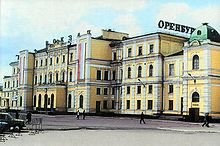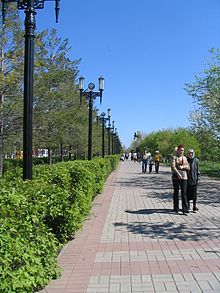- Orenburg
-
Orenburg (English)
Оренбург (Russian)- City[citation needed] - 
Street in OrenburgCoordinates: 51°47′N 55°06′E / 51.783°N 55.1°ECoordinates: 51°47′N 55°06′E / 51.783°N 55.1°E Coat of arms Flag Administrative status Country Russia Federal subject Orenburg Oblast Administrative center of Orenburg Oblast[citation needed] Municipal status Urban okrug Orenburg Urban Okrug[citation needed] Mayor[citation needed] Yury Meshcheryakov[citation needed] Representative body City Duma[citation needed] Statistics Population (2010 Census,
preliminary)546,987 inhabitants[1] - Rank in 2010 29th Population (2002 Census) 549,361 inhabitants[2] - Rank in 2002 27th Time zone YEKST (UTC+06:00)[3] Founded 1743[citation needed] Postal code(s) 460000[citation needed] Dialing code(s) +7 3532[citation needed] Official website Orenburg (Russian: Оренбу́рг) is a city on the Ural River and the administrative center of Orenburg Oblast, Russia. It lies 1,478 kilometers (918 mi) southeast of Moscow, very close to the border with Kazakhstan. Population: 546,987 (2010 Census preliminary results);[1] 549,361 (2002 Census);[2] 546,501 (1989 Census).[4] Highest point: 154.4 m. As of 2006, the mayor of the city is Yury Meshcheryakov.
Contents
History
The Russian Empire began plans for the expansion into Asia by construction of an eastern frontier fortress town in the southern Ural region to be named Orenburg in 1734. The colonists originally founded a settlement in 1735 at the confluence of the Ural River with the Or River. The town's name meant "fortress near the Or," as Burg is German for fortress. This settlement changed its name in 1739 to Orsk. An attempt was made to found another Orenburg about 175 km west at a location called Krasnogor, or "Red Hill," in 1741, but this settlement failed. A third Orenburg was successfully established by Ivan Neplyuyev at its present location approximately 250 km west down the Ural from Orsk in 1743. For more background and the 'Orenburg Line' of forts, see Bashkirs.
This third Orenburg functioned as an important military outpost on the frontier with the nomadic Kazakhs. It became the center for the Orenburg Cossacks.
Orenburg played a major role in the Pugachev rebellion (1773–1774). At the time, it was the capital of a vast district and the seat of the governor. Yemelyan Pugachev besieged the city and its fortress from nearby Berda from October 1773 - March 26, 1774. The defense was organized by lieutenant-general Reinsdorp. General Golytsin[disambiguation needed
 ] defeated Pugachev at Berda, and later again at Kargala (north of Orenburg). Most of the city was left in ruins, and thousands of inhabitants had died in the siege.
] defeated Pugachev at Berda, and later again at Kargala (north of Orenburg). Most of the city was left in ruins, and thousands of inhabitants had died in the siege.The famous Russian writer Alexander Pushkin visited Orenburg in 1833 during a research trip for his books "The History of Pugachev" and his famous novel "The Captain's Daughter". He met his friend Vladimir Dahl here, who would later write the first serious dictionary of the Russian language.
Orenburg was the base for General Perovsky's expeditions against the Khanate of Khiva in the 1830s through 1850s. After the incorporation of Central Asia into the Russian Empire, Orenburg became a trading station and, since the completion of the Trans-Aral Railway, a prominent railway junction on route to the new Central Asian possessions and to Siberia.
Orenburg functioned as the capital of the Kyrgyz Autonomous Soviet Socialist Republic (in present-day Kazakhstan) within Russia from 1920–1925. When that republic was renamed Kazakh Autonomous Soviet Socialist Republic in 1925, Orenburg joined Russia and Qyzylorda became the new capital. Alma-Ata became the capital in 1929 after the construction of the Turksib railway. Kazakh Autonomous Soviet Socialist Republic was promoted to the union republic status as the Kazakh Soviet Socialist Republic Kazakh SSR in 1936. Orenburg remained in Russia.
From 1938 to 1957, the city bore the name Chkalov (Чка́лов) (after the test pilot Valery Chkalov). The city's distance from the German invasion during World War II led many Soviet enterprises to flee there, helping to spur the city's economic growth.
Economy
Orenburg is a home for several large companies or their subsidiaries: Orenburggazprom[5], the subsidiary of Gazprom; Orenburgneft[6], the subsidiary of TNK-BP oil company; Orenburgenergy, one of the biggest energy generating companies in Russia.
Transportation
Orenburg has been a major railroad center ever since the Samara-Zlatoust (ru:Самаро-Златоустовская железная дорога) and Orenburg-Tashkent railroads were completed, respectively in 1876 and 1905.[7]
Orenburg's main airport is Orenburg Tsentralny Airport[8], located about 25 km east of the city,on the Orsk destination, and is the headquarters of Orenair[8].
Life and culture
Orenburg is a regional center of education and has a number of cultural institutions and museums.
Education
- Orenburg State University
Established in 1955 as a Branch of Kuibyshev Polytechnical Institute (currently Samara State Technical University). It was transformed to the Orenburg Polytechnical Institute in 1971. In 1994 it was named as Orenburg State Technical University. Gained status of university in 1996. Currently, there are 18 Faculties, 3 Research & Development institutes, 4 Regional Branches, technology incubator “OSU Technopark”, botanic garden, meteorological station, sport complex.
- Orenburg State Institute of Management (OSIM)
Established in 1991. Orenburg State Institute of Management (OSIM) one of the leader in the academic fields of economics, management, information technologies, information securing, business informatics and innovation.
- Orenburg State Medical Academy
Established in 1944 as Chkalov State Medical Institute. It was renamed to Orenburg State Medical Institute in 1957 (at that time Orenburg city regained its original name after being named Chkalov from 1937 till 1957). Gained status of academy in 1994. Currently there are 8 Faculties: Medicine, Pediatric, Stomatology (Dentistry), Pharmacy, Clinical Psychology, Nursing, Public Health (Медико-профилактический), Continuing Education.
- Orenburg State Pedagogical University
Established in 1919 as Institute of Public Education. Renamed to Pedagogical Institute in 1930. Transformed to Pedagogical University in 1996. There are 10 Faculties and 4 Research Institutes.
- Orenburg State Agrarian University
Established in 1930 as Orenburg Agricultural Institute. It was transformed to Orenburg State Agricultural Academy in 1992. Since 1995 named as Orenburg State Agrarian University. There are 8 Faculties and 4 Institutes.
- Orenburg Branch of Moscow State Law Academy
- Orenburg Branch of Gubkin Russian State University of Oil and Gas
- Orenburg Campus of Russian State University of Trade and Economics
Museums
- Orenburg Regional Museum of History and Natural Science
- Orenburg Regional Museum of Art
- Museum of Orenburg History
- Memorial Apartment of Yuri and Valentina Gagarin
- Memorial Apartment of Leopold and Mstislav Rostropovich
- Memorial Apartment of T.G. Shevchenko
- Orenburg City Memorial House
Theaters
- Orenburg Maxim Gorky State Dramatic Theater [1]
- Orenburg State Regional Musical Theater [9]
- Orenburg State Tatar Dramatic Theater
- Orenburg State Regional Puppet Theater
- Orenburg Municipal Puppet Theater "Pierrot
- Orenburg Municipal Chamber Choir
- Orenburg State Academic Russian Folk Choir
Sports
Lokomotiv plays in the highest division of the Russian Bandy League.
Tourism
Mountain and river tourism is developed in the region. There are a number of fast mountain rivers and rocks in pleated spurs of the southern edge of the Urals range, popular with tourists.
The city is famous for its down Orenburg shawls. The thinnest lacy design, knitted by hand shawls and cobweb-like kerchiefs (pautinkas), is not only warm, but also is used for decorative purposes.
Architecture
A famous boulevard on the embankment of the Ural River is one of the most notable places in Orenburg.
Orenburg TV Tower is a guyed mast of unusual design. It is a 200-meter (660 ft) tall mast equipped with six crossbars running from the mast structure to the guys [10].
Notable residents
- Ivan Krylov (1769–1844), Russia's best known fabulist.
- Vasily Alekseevich Perovsky (1794—1857), prominent Russian statesman, Count, Governor of Orenburg Province from 1833–1842 and 1851-1857
- Vladimir Dahl (1801–1872), Russian lexicographer
- Yevgraf Fyodorov (1853–1919), mathematician, crystallographer, and mineralogist
- Paul Nazaroff (1890–1942), Russian geologist and writer
- Joseph Kessel (1898–1979), French journalist and novelist
- Musa Cälil (1906–1944), Tatar poet
- Alexander Schmorell (1917–1943), one of five Munich University students who formed anti-Nazi group known as White Rose, Weiße Rose.
- Mstislav Rostropovich 1927–2007), Russian cellist
- Yuri Gagarin (1934–1968), Soviet cosmonaut
- Denis Istomin (born 1986), tennis player
Honors
The asteroid 27709 Orenburg was named after the city on June 1, 2007.†
Sister cities
Orenburg has the following sister cities:[11]
 Khujand, Tajikistan
Khujand, Tajikistan Legnica, Poland
Legnica, Poland Orlando, United States
Orlando, United States Ufa, Russia
Ufa, Russia Oral, Kazakhstan
Oral, Kazakhstan
External links
References
- ^ a b Федеральная служба государственной статистики (Federal State Statistics Service) (2011). "Предварительные итоги Всероссийской переписи населения 2010 года (Preliminary results of the 2010 All-Russian Population Census)" (in Russian). Всероссийская перепись населения 2010 года (All-Russia Population Census of 2010). Federal State Statistics Service. http://www.perepis-2010.ru/results_of_the_census/results-inform.php. Retrieved 2011-04-25.
- ^ a b Федеральная служба государственной статистики (Federal State Statistics Service) (2004-05-21). "Численность населения России, субъектов Российской Федерации в составе федеральных округов, районов, городских поселений, сельских населённых пунктов – районных центров и сельских населённых пунктов с населением 3 тысячи и более человек (Population of Russia, its federal districts, federal subjects, districts, urban localities, rural localities—administrative centers, and rural localities with population of over 3,000)" (in Russian). Всероссийская перепись населения 2002 года (All-Russia Population Census of 2002). Federal State Statistics Service. http://www.perepis2002.ru/ct/doc/1_TOM_01_04.xls. Retrieved 2010-03-23.
- ^ Правительство Российской Федерации. Постановление №725 от 31 августа 2011 г. «О составе территорий, образующих каждую часовую зону, и порядке исчисления времени в часовых зонах, а также о признании утратившими силу отдельных Постановлений Правительства Российской Федерации». Вступил в силу по истечении 7 дней после дня официального опубликования. Опубликован: "Российская Газета", №197, 6 сентября 2011 г. (Government of the Russian Federation. Resolution #725 of August 31, 2011 On the Composition of the Territories Included into Each Time Zone and on the Procedures of Timekeeping in the Time Zones, as Well as on Abrogation of Several Resolutions of the Government of the Russian Federation. Effective as of after 7 days following the day of the official publication).
- ^ "Всесоюзная перепись населения 1989 г. Численность наличного населения союзных и автономных республик, автономных областей и округов, краёв, областей, районов, городских поселений и сёл-райцентров. (All Union Population Census of 1989. Present population of union and autonomous republics, autonomous oblasts and okrugs, krais, oblasts, districts, urban settlements, and villages serving as district administrative centers.)" (in Russian). Всесоюзная перепись населения 1989 года (All-Union Population Census of 1989). Demoscope Weekly (website of the Institute of Demographics of the State University—Higher School of Economics. 1989. http://demoscope.ru/weekly/ssp/rus89_reg.php. Retrieved 2010-03-23.
- ^ http://www.gazprom.com/eng/articles/article28937.shtml
- ^ http://www.tnk-bp.com/operations/enterprises/orenburgneft/
- ^ http://query.nytimes.com/mem/archive-free/pdf?_r=1&res=9E07E1D7123AE733A25754C0A9679D946597D6CF
- ^ a b http://www.airoport.orenair.ru/index.php?eng=1
- ^ http://www.orenburg.ru/culture/theatre/
- ^ http://vcfm.ru/vc/Cities/orenburg.htm
- ^ profile documents, Orenburg
Cities and towns in Orenburg Oblast Administrative center: Orenburg Abdulino · Buguruslan · Buzuluk · Gay · Kuvandyk · Mednogorsk · Novotroitsk · Orsk · Sol-Iletsk · Sorochinsk · Yasny
Abdulino · Buguruslan · Buzuluk · Gay · Kuvandyk · Mednogorsk · Novotroitsk · Orsk · Sol-Iletsk · Sorochinsk · Yasny Categories:
Categories:- Cities and towns in Orenburg Oblast
- Orenburg
- Populated places established in 1743
Wikimedia Foundation. 2010.







